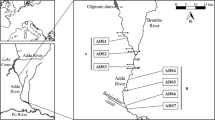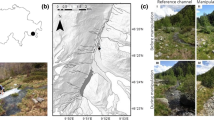Abstract
Reduction of flow constitutes one of the most severe human alterations to rivers, as it affects the key abiotic feature of these ecosystems. While there has been considerable progress in understanding the effects of reduced flow on benthic macroinvertebrates, cascading effects of flow reduction on dissolved oxygen concentrations (DO) have not yet received much attention. We compared the macroinvertebrate composition between reference conditions and a situation after several years of discharge reduction in the Spree River (Brandenburg, Germany). Community composition shifted from rheophilic species to species indifferent to flow conditions. Filter feeders were partially replaced by collector/gatherers, which likely reduces the retention of organic matter, and thus the self-purification capacity of the river section. These shifts were associated with low discharge during summer, cascading into daily DO concentration minima of less than 5 mg l−1 which prevailed 74% of the days in summer. This depletion of DO after flow reduction presumably caused the observed species turnover. Hence, flow reduction in lowland rivers may not only directly impair the ecological functions provided by benthic macroinvertebrates but may also act indirectly by depleting DO concentrations.



Similar content being viewed by others
References
Alexander, J. E. & R. F. McMahon, 2004. Respiratory response to temperature and hypoxia in the zebra mussel Dreissena polymorpha. Comparative Biochemistry and Physiology A-Molecular & Integrative Physiology 137: 425–434.
Armitage, P. D. & G. E. Petts, 1991. Biotic score and prediction to assess the effects of water abstractions on river macroinvertebrates for conservation purposes. Aquatic Conservation: Marine and Freshwater Ecosystems 2: 1–17.
Bayne, B. L., 2009. Carbon and nitrogen relationships in the feeding and growth of the Pacific oyster, Crassostrea gigas (Thunberg). Journal of Experimental Marine Biology and Ecology 374: 19–30.
Bickerton, M. A., 1995. Long-term changes of macroinvertebrate communities in relation to flow variations—the River Glen, Lincolnshire, England. Regulated Rivers-Research & Management 10: 81–92.
Botta-Dukát, Z., 2005. Rao’s quadratic entropy as a measure of functional diversity based on multiple traits. Journal of Vegetation Science 16: 533–540.
Brunke, M., A. Hoffmann & M. Pusch, 2001. Use of mesohabitat-specific relationships between flow velocity and river discharge to assess invertebrate minimum flow requirements. Regulated Rivers-Research & Management 17: 667–676.
Canadian Council of Ministers of the Environment, 1999. Canadian water quality guidelines for the protection of aquatic life: dissolved oxygen (freshwater). Canadian environmental quality guidelines.
Castella, E., E. Bickerton, P. D. Armitage & G. E. Petts, 1995. The effects of water abstractions on invertebrate communities in U.K. streams. Hydrobiologia 308: 167–182.
Cazaubon, A. & J. Giudicelli, 1999. Impact of the residual flow on the physical characteristics and benthic community (algae, invertebrates) of a regulated Mediterranean river: The Durance, France. Regulated Rivers-Research & Management 15: 441–461.
Chen, L.-Y., A. G. Heath & R. J. Neves, 2001. Comparison of oxygen consumption in freshwater mussels (Unionidae) from different habitats during declining dissolved oxygen concentration. Hydrobiologia 450: 209–214.
Connolly, N. M., M. R. Crossland & R. G. Pearson, 2004. Effect of low dissolved oxygen on survival, emergence, and drift of tropical stream macroinvertebrates. Journal of the North American Benthological Society 23: 251–270.
Decker, A. S., M. J. Bradford & P. S. Higgins, 2008. Rate of biotic colonization following flow restoration below a diversion dam in the Bridge River, British Columbia. River Research and Applications 24: 876–883.
Dewson, Z. S., A. B. W. James & R. G. Death, 2007. A review of the consequences of decreased flow for instream habitat and macroinvertebrates. Journal of the North American Benthological Society 26: 401–415.
Dunbar, M. J., M. L. Pedersen, D. Cadman, C. Extence, J. Waddingham, R. Chadd & S. E. Larsen, 2010. River discharge and local-scale physical habitat influence macroinvertebrate LIFE scores. Freshwater Biology 55: 226–242.
Dussart, G. B. J., 1979. Sphaerium corneum (L.) and Pisidium spp. Pfeiffer – the ecology of freshwater bivalve molluscs in relation to water chemistry. Journal of Molluscan Studies 45: 19–34.
Gergs, R., K. Rinke & K. O. Rothhaupt, 2009. Zebra mussels mediate benthic-pelagic coupling by biodeposition and changing detrital stoichiometry. Freshwater Biology 54: 1379–1391.
Harris, R. R. & I. B. Musko, 1999. Oxygen consumption, hypoxia, and tube-dwelling in the invasive amphipod Corophium curvispinum. Journal of Crustacean Biology 19: 224–234.
Haylock, M. R., N. Hofstra, A. M. G. Klein Tank, E. J. Klok, P. D. Jones & M. New, 2008. A European daily high-resolution gridded data set of surface temperature and precipitation for 1950–2006. Journal of Geophysical Research 113: D20119.
Horrigan, N. & D. J. Baird, 2008. Trait patterns of aquatic insects across gradients of flow-related factors: a multivariate analysis of Canadian national data. Canadian Journal of Fisheries and Aquatic Sciences 65: 670–680.
Jowett, I., 1997. Environmental effects of extreme flows. In Mosley, M. P. & C. P. Pearson (eds), Floods and Droughts: The New Zealand Experience. Caxton Press, Christchurch, New Zealand: 103–116.
Joyner-Matos, J., L. J. Chapman, C. A. Downs, T. Hofer, C. Leeuwenburgh & D. Julian, 2007. Stress response of a freshwater clam along an abiotic gradient: too much oxygen may limit distribution. Functional Ecology 21: 344–355.
Laliberté, E. & P. Legendre, 2010. A distance-based framework for measuring functional diversity from multiple traits. Ecology 91: 299–305.
Ledger, M. E., F. K. Edwards, L. E. Brown, A. M. Milner & G. Woodward, 2011. Impact of simulated drought on ecosystem biomass production: an experimental test in stream mesocosms. Global Change Biology 17: 2288–2297.
Ledger, M. E., L. E. Brown, F. K. Edwards, A. M. Milner & G. Woodward, 2012. Drought alters the structure and functioning of complex food webs. Nature Climate Change 3: 223–227.
Lorenz, S., F. Gabel, N. Dobra & M. T. Pusch, 2012. Modelling the effects of recreational boating on self-purification activity provided by bivalve mollusks in a lowland river. Freshwater Science 82–93.
Malmqvist, B. & A. Eriksson, 1995. Benthic insects in Swedish lake-outlet streams : patterns in species richness and assemblage structure. Freshwater Biology 34: 285–296.
Malmqvist, B., S. Rundle, C. Brönmark & A. Erlandsson, 1991. Invertebrate colonization of a new, man-made stream in southern Sweden. Freshwater Biology 26: 307–324.
McMahon, R. F., 1996. The physiological ecology of the zebra mussel, Dreissena polymorpha, in North America and Europe. American Zoologist 36: 339–363.
Miller, S. W., D. Wooster & J. Li, 2007. Resistance and resilience of macroinvertebrates to irrigation water withdrawals. Freshwater Biology 52: 2494–2510.
Miltner, R. J., 2010. A method and rationale for deriving nutrient criteria for small rivers and streams in Ohio. Environmental Management 45: 842–855.
Morrill, J., R. Bales & M. Conklin, 2005. Estimating stream temperature from air temperature: implications for future water quality. Journal of Environmental Engineering 131: 139–146.
Muggeo, V. M. R., 2003. Estimating regression models with unknown break-points. Statistics in Medicine 22: 3055–3071.
Naddafi, R., P. Eklov & K. Pettersson, 2009. Stoichiometric constraints do not limit successful invaders: zebra mussels in Swedish lakes. PLoS ONE 4: e5345.
Nebeker, A. V., 1972. Effect of low oxygen concentration on survival and emergence of aquatic insects. Transactions of the American Fisheries Society 101: 675–679.
Oksanen J., F. G. Blanchet, R. Kindt, P. Legendre, P. R. Minchin, R. B. O’Hara, G. L. Simpson, P. Solymos, M. H. H. Stevens & H. Wagner, 2011. Vegan: Community Ecology Package.
Parr, L. B. & C. F. Mason, 2004. Causes of low oxygen in a lowland, regulated eutrophic river in Eastern England. Science of the Total Environment 321: 273–286.
Poepperl, R., 1999. Functional feeding groups of a macroinvertebrate community in a Northern German lake outlet (Lake Belau, Schleswig-Holstein). Limnologica 29: 137–145.
Pusch, M. & A. Hoffmann, 2000. Conservation concept for a river ecosystem (River Spree, Germany) impacted by flow abstraction in a large post-mining area. Landscape and Urban Planning 51: 165–176.
R Development Core Team, 2012. R: A Language and Environment for Statistical Computing. R Foundation for Statistical Computing, Vienna, Austria.
Richardson, J. S. & R. J. Mackay, 1991. Lake outlets and the distribution of filter feeders – an assessment of hypotheses. Oikos 62: 370–380.
Sabater, S., 2008. Alterations of the global water cycle and their effects on river structure, function and services. Freshwater Reviews 1: 75–88.
Schmidt-Kloiber, A., W. Graf, A. Lorenz & O. Moog, 2006. The AQEM/STAR taxalist – a pan-European macro-invertebrate ecological database and taxa inventory. Hydrobiologia 566: 325–342.
Tachet, H., 2010. Invertébrés d’eau douce: Systématique, biologie, écologie. CNRS, Paris, France.
Venohr, M., U. Hirt, J. Hofmann, D. Opitz, A. Gericke, A. Wetzig, S. Natho, F. Neumann, J. Hürdler, M. Matranga, J. Mahnkopf, M. Gadegast & H. Behrendt, 2011. Modelling of nutrient emissions in river systems – MONERIS – methods and background. International Review of Hydrobiology 96: 435–483.
Wanner, S. C., K. Ockenfeld, M. Brunke, H. Fischer & M. Pusch, 2002. The distribution and turnover of benthic organic matter in a lowland river: influence of hydrology, seston load and impoundment. River Research and Applications 18: 107–122.
Wood, P. J. & P. D. Armitage, 1999. Sediment deposition in a small lowland stream – management implications. Regulated Rivers-Research & Management 15: 199–210.
Wotton, R. S., 1988. Very high secondary production at a lake outlet. Freshwater Biology 2: 341–346.
Wotton, R. S., C. P. Joicey & B. Malmqvist, 1996. Spiralling of particles by suspension feeders in a small lake-outlet stream. Canadian Journal of Zoology-Revue Canadienne de Zoologie 74: 758–761.
Acknowledgments
Thanks to Jürgen Schreiber, Jens Bunzel, Christina Taraschewski and Mark Leszinski for their assistance with the field and laboratory work and to Marianne Graupe, Barbara Meinck, Hannah Winckler and Grit Siegert for the seston measurements. We thank Jens Hürdler for precipitation modeling and the Environmental Agency of Brandenburg (Landesumweltamt Brandenburg) for providing the discharge data.
Author information
Authors and Affiliations
Corresponding author
Additional information
Handling editor: Mariana Meerhoff
Electronic supplementary material
Below is the link to the electronic supplementary material.
Rights and permissions
About this article
Cite this article
Graeber, D., Pusch, M.T., Lorenz, S. et al. Cascading effects of flow reduction on the benthic invertebrate community in a lowland river. Hydrobiologia 717, 147–159 (2013). https://doi.org/10.1007/s10750-013-1570-1
Received:
Revised:
Accepted:
Published:
Issue Date:
DOI: https://doi.org/10.1007/s10750-013-1570-1




